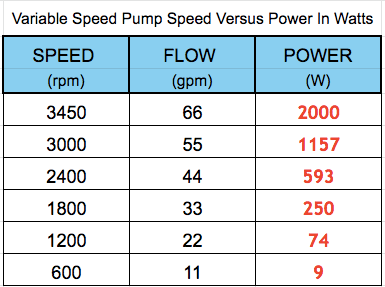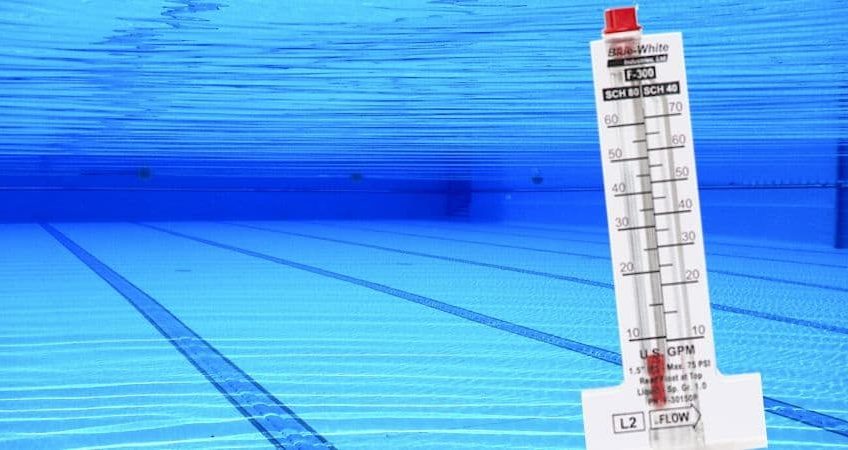This independent website is funded by its readers. It can earn a commission on any purchases made through product links, at no extra cost to the buyer. Learn more >
If you knew installing a swimming pool flow meter could save you money you’d be interested, right ? But if you knew it could save you a lot of money then you’d be very interested.
Adding a cheap flow meter to your pool plumbing can save hundreds of dollars a year on some pool installations. It may sound a little far fetched, but we’re going to show you why.
And when you understand how you’ll wonder why all domestic swimming pools don’t have a pool flow meter installed.
The Importance Of Pool Circulation
Everyone knows a pool needs to be circulated at least once a day. Twice or three times a day is better. Circulated means the entire pool volume filtered through the surface equipment once. Thats why it’s called a complete circulation.
There’s quite a lot to unpack to decide when and how long to run the pool pump. A pool needs to be filtered, chemicals dispersed and the surface skimmed. Additional equipment like solar panels, or a pool heater have got to be taken into account too.
But how many pool owners are able to calculate what a complete circulation actually means ? How many hours to run the pool pump. You’ll often see the number 8 as a minimum number of hours to run the pool pump every day. But what’s that based on ? Well the simple answer is nothing. Without proper calculations it’s meaningless.
It sounds a pretty easy calculation too. Just take the pool water volume and divide it the gallons per hour and there’s your answer. Simple !
That’s true it is, but OOPS ! there’s a problem. Pumps are sold by HorsePower not gallons per minute or gallons per hour and all plumbing setup are different. Yikes ! Let’s dig a little deeper here.!
Why Are Pool Pumps Sold By HorsePower
You’ll find it’s a little tricky to round up all the data you need for your simple calculation. Here’s why. Pumps are sold on HorsePower not GPM. There’s a couple of good reasons for that.
Obviously a pump does have a measurable output of water. If there’s nothing attached to it then it’s a simple calculation. Things change when it’s connected into a pool system though . They can change a little or a lot. The volume of water a pump delivers to your pool is directly related to everything attached to it.
That’s one reason why it’s difficult for the manufacturer to advertise a meaningful GPM value. It’s one compelling reason why you need a pool flow meter fitted.
So the amount of water circulated to your pool is related to the diameter of the pipe, the length of pipe, how many bends in the pipe, the type of filter, if there’s a multivalve in the system, and how many other valves are in the system also factor in. There’s a lot of things here, but wait there’s more. Expect a further reduction if you’ve got a heater or solar panels plumbed in. Even when your filter is dirty will reduce flow rate to the pool a tad.
“Feet of head” is the combined result of everything listed above. Pump manufacturers have had a stab at estimating the difference feet of head scenarios make to their pumps performance. Feet of head tables make an educated estimate on GPM volumes being pumped into a pool.
But at the end of the day they’re just a best calculated guess. To top it all off these tables are often hard to find on some manufacturers websites.
Data To Calculate Flow Rate Into A Pool
So now we’ve scoured the internet, found our pool pump model on line, and discovered our feet of head tables. Now we’re nearly ready to get this darned calculation done.
But hang on, wait just a minute. What if you’ve scoured the internet and couldn’t find your pump or feet of head tables. Worse still you have no idea what pump is installed on your system. Maybe the manufacturers label has weathered off or it never had one
Well your calculations have ground to a halt again. This is getting frustrating. Finding the information to do a little simple school boy math has turned into a nightmare.
Do You Need A Flow Meter For Your Pool ?
Sure you do if you want to calculate your flow rate the right way. Let’s forget theoretical calculations, flowcharts and tables and join the real world.
We just need a pool flow meter, how simple is that. It’s the only real way to know how many GPH is being pumped to your pool. Installing a flow meter to the pool plumbing discharge side, it’s a “no brainer” and it’s cheap.
Why guess and estimate when you can read an exact value off a flow meter. Commercial swimming pools must be fitted with a flow meter. They’re subject to regular city inspections. No guesses or estimates here. The inspector needs to see the hourly volume of water being pumped through the pool. It’s a major factor in verifying the health of the water.
In our case we need a pool flow meter for the all the same reasons. The difference is we’re paying our energy bills. Having a flow meter installed insures our pool pump isn’t running more than it needs to. If it is then we’re just throwing money away.
- 1. 5" FlowVis flow meter, FV-C-15
- Installation flexibility; installs horizontally, vertically, or even upside-down
- Clear, easy-to-read scale in GPM with key velocity points (FPS)
Flow Meters And Variable Speed Pumps
A pool flow meter will be even more important in the near future. The pool industry and state governments are finally addressing the amount of energy expended on running a pool pump. California has been way ahead of the game in enforcing strict guidelines for pool pump specification.
With this in mind single speed (3450 rpm) and two speed pumps (3450 or 1725 rpm) will almost certainly be forced and phased out in favour of variable speed pumps nation wide. It’s a good thing, a very good thing, but it amplifies all the issues we’ve looked at above.
With three four or more variable speed settings on the pump how do we know how much water we are circulating into the pool every day. The answer is we don’t, and the solution is fitting a pool flow meter to monitor things.
Some high end variable speed pumps do come equipped with a built in flow meters but most don’t. With the complexity of variable speed pump flow rates manufactures now have made graphs of TDH (Total Dynamic Head) vs GPM more readily available.

Pool Flow Meters And Pool Heaters
Minimum and maximum recommended flow are posted with all pool heaters . Fall below a certain flow rate and the pool heater won’t operate efficiently.
So pool heaters have been equipped with pressure sensors that monitor and detects low flow, Too low and warning light will pop up on the control panel. It’s obvious that if insufficient volume of heated water is sent to the pool it won’t heat up.
If you’ve a heater installed the pool flow meter should be fitted between the filter and heater. Ideally it should always be at the last piece of equipment set up right at the end of the return line to the pool with a heater it’s not advisable. Scalding hot water running past the flow meter isn’t a great idea.
How Can A Flow Meter Save Money
Knowing the exact volume of water returning to the pool lets you make a precise calculation to decide how many hours to run your pump.
Here’s where we get to lack of understandable data and overselling of pool pumps.
What does that even mean ? Well if there’s no real clear information the pool owner can understand there’s generally two tendencies, One is to run the pump too much because a lot is better than a little. And the other is not run it enough and wait until problems occur then solve them.
Now overselling or overbuying a pool pump has been very common indeed. Just like thinking a lot is better than a little there’s a similar idea that bigger is best when it comes to pool pumps.
It’s all to do with that darn HorsePower thing again. Half a HorsePower, Two HorsePower, what does it all mean. Because of the lack of understanding we’ve seen 1.5 HP pumps circulating 15000 gallon pools for 12 hours or more.
One pool owner was astonished to see the flow meter results that the pool was being circulated four times. Why did he buy the 1.5 HP pump ? Because bigger is better, and maybe it is if you understand when to turn it off.
Knowing exact GPM figures means you can run your times pump precisely. No more guessing. Two circulations a day is optimum, one is minimum, and a pool flow meter puts you in control with correct real data to work from.
It’s just an all round no brainer !!!
Related Articles
Images from Amazon Product Advertising












